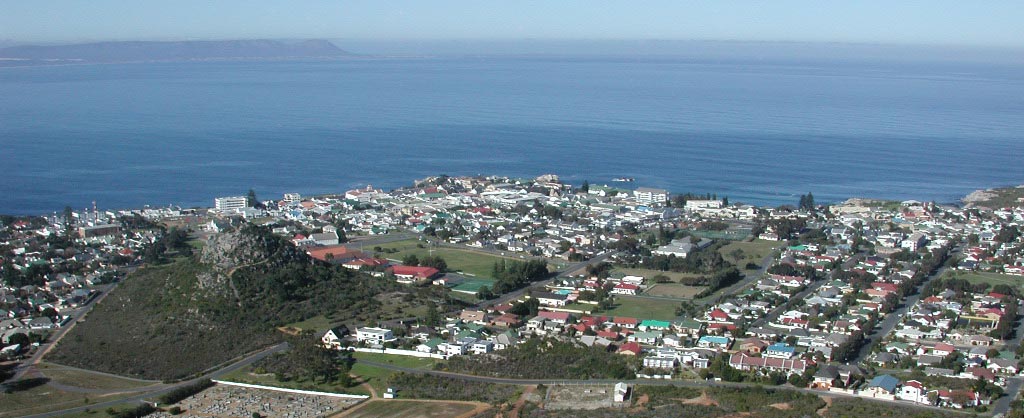
Hermanus has been described in many ways. “Village of the Sea” showcases the fishing and holiday life. “Riviera of the South” focusses on the reputation of the town to tourists and the health conscious. “Whale capital” of the ‘whale coast’, which offers the ‘best land-based whale watching in the world’, refers to the recent rise in environmental tourism. For others, Hermanus is the centre of the fynbos region, with natural botanical riches for research, collecting and painting.
But Hermanus has not yet attracted people because of its history. Luckily, that is about to change. Hermanus is poised to take its place in documenting its past – which is rich and colourful – and conveying this in a lively way to residents, visitors and tourists. The leading spirit behind this is the newly-formed Hermanus History Society, whose aim is to bring the history of the town alive to residents and visitors.
“Hermanus” – since 1902 the first name of a real person has been the official designation of this bustling town. In the 1820s , Hermanus Pieters, an itinerant schoolmaster, was told by people working at the leper colony in the Hemel-en-Aarde valley about a ‘fontein’ or spring of fresh water, flowing into the sea roughly where Marine Drive today passes Swallow Park – also named for a real schoolteacher, Magdalena ‘Swallow” Neethling.(We’ll tell her story later). He located the spring and later talked to farmers back in his base in the Boontjieskraal area near present day Caledon about the good grazing to be found there. Gradually the area around it became known as Hermanuspietersfontein (the spring of Hermanus Pieters).
However, at least three decades were to go by before anyone settled in the area. This did not happen until after the wreck of the British troopship the Birkenhead at Danger Point had drawn in fisher folk then living at Herries Bay – the present Hawston. They came upon the safe inlet we now call the Old Harbour and decided to move their fishing boats and themselves to the new area in 1855. From then on the name of a village Hermanuspietersfontein begins to appear in the official documents of the time.
The first family to settle were the Henn family – and some of their descendants live in Hermanus and Hawston to this day.
It goes without saying that the history of human beings in the area goes back thousands of years before the Europeans came along. Discoveries in coastal caves show that early homo sapiens was living in and around the area as long as 70 000 years ago – a decorated stick of ochre found at Blombos cave near Stilbaai has been accurately dated to this era.
In the period 1600 to 1800 tribes of the hunter-gathering Khoi also passed through, but let no settlements. Strandlopers –solitary beachcombers – lived in caves along the shore. The legendary last of these - a lady by the name of Bientang - is associated with a specific cave near the Old Harbour, which is now a popular restaurant.
Expansion from the Cape saw the first farm granted to a white settler in 1724 and the first permanent structure –a holiday home- was in existence by 1798, on the shore of the Klein River estuary and known as de Mondhuis. In a beautifully restored form it is there still.
The economy of the early town was fishing, but gradually the healthy climate began to attract recuperating patients and with them a settled population seeing to the needs of the visitors. In 1897 the present Windsor Hotel was originally built as a sanatorium for tuberculosis patients.
In 1902 the name of Hermanuspietersfontein was officially changed to Hermanus on the motivation of the Post Office. The town grew slowly through the early years of the 20th century, but, in the 1940s an artist’s colony grew up at Onrus and, since the 1960s, retirement villages and complexes have brought in a whole new and quite affluent population. As this grew, younger people and many professionals moved to Hermanus to serve the needs of the growing settled population and in search of good education and a safe environment for their children.
Alongside the white town a ‘colored settlement’ (Mount Pleasant) was inaugurated in 1930 and a ‘black’ township (Zwelihle) in 1957. Today Hermanus boasts a permanent population of nearly 50 000, rising to as many as 90 000 at the height of the summer holiday season.
All of this information, and much more, is contained in a display prepared by the Hermanus History and erected at a site adjacent to the original spring. The Society is a voluntary association of residents which aims to bring alive to residents and visitors the fascinating history of our town. Anyone interested in joining the Society should contact Dr Robin Lee on 028 312 4072 or at robinlee@hermanus.co.za.
